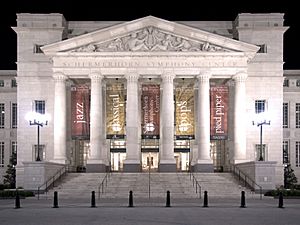Schermerhorn Symphony Center facts for kids

Schermerhorn main entrance in 2007
|
|
| Address | One Symphony Place Nashville, Tennessee 37201-2031 |
|---|---|
| Coordinates | 36°9′35″N 86°46′31″W / 36.15972°N 86.77528°W |
| Owner | City of Nashville |
| Type | Concert hall |
| Capacity | 1,844 (Laura Turner Concert Hall) |
| Field size | 197,000 sq ft (18,300 m2) |
| Construction | |
| Broke ground | December 3, 2003 |
| Built | April 26, 2005 |
| Opened | September 9, 2006 |
| Construction cost | US$123.5 million |
| Architect | Earl Swensson Associates David M. Schwarz Architects Hastings Architecture Associates |
| Project manager | Donnell Consultants |
| Structural engineer | KSi Structural Engineers |
| Services engineer | I.C. Thomasson & Associates |
| General contractor | American Constructors, Inc. |
| Tenants | |
| Nashville Symphony (2006-present) | |
The Schermerhorn Symphony Center is a beautiful concert hall located in downtown Nashville, Tennessee. It's a special place where the Nashville Symphony performs. Construction on the building started on December 3, 2003. The center officially opened its doors on September 9, 2006. The first concert was a big event, led by Leonard Slatkin, and it was even shown on TV across the state.
The center is named after Kenneth Schermerhorn. He was the music director and conductor of the Nashville Symphony for many years. He led the orchestra from 1983 until he passed away in 2005. The building was named in his honor even before he died. This building is a great example of modern New Classical architecture.
Building Design and Features
The main part of the Schermerhorn Symphony Center is the Laura Turner Concert Hall. This large hall is about 30,000 square feet and has 1,844 seats. It is the home of the Nashville Symphony. The hall is designed in a "shoebox style," which means it's long and narrow like a shoebox. This shape helps the sound travel well.
Natural light fills the hall through 30 special windows. These windows are soundproof, so no outside noise gets in. You can see many interesting symbols throughout the hall and the rest of the building. These include irises, which are the state flower of Tennessee. There are also horseshoes, honoring Laura Turner's love for horses. You might even spot coffee beans, representing a family important to the symphony's history.
The seats in the Laura Turner Concert Hall are on three different levels. There's even a special area behind the stage for up to 146 chorus members. When there's no choir, audience members can sit there. The stage is big enough for 115 musicians. The hall also has a huge pipe organ called the Martin Foundation Concert Organ. It has 3,568 pipes and makes amazing sounds!
The building's design is called Neoclassical. This style mixes ideas from old Greek and Roman buildings. It fits in with other famous buildings in Nashville. For example, it looks similar to the full-size Parthenon replica and the city's main public library.
Inside the building, there are cool high-tech features. The seats on the main floor can move! They are on special platforms that can be lowered through the floor. This reveals a beautiful wooden floor. These moving seats can change the concert hall into a large ballroom in about two hours. Many motorized curtains and panels can also be adjusted. This helps change the sound of the hall for different types of music. The Laura Turner Concert Hall is also very quiet inside. It has a special 2-inch gap around it that stops outside noise from getting in.
The Schermerhorn Symphony Center also has other important spaces. The Mike Curb Family Music Education Hall is a smaller area. It's used for smaller shows and for the symphony's music education programs. There's also a public garden called the Martha Rivers Ingram Garden Courtyard. It's a lovely outdoor space with columns. Because the center has so many different rooms, it's often used for public and private events.
The building was designed by David M. Schwarz Architects, Inc. Earl Swensson Associates from Nashville also helped. Paul Scarbrough was in charge of making sure the sound in the hall was perfect.
Awards and Recognition
In 2009, the Schermerhorn Symphony Center received a special honor. It was chosen as one of the top 25 buildings in North and South America for an award. These awards celebrate buildings that have great design. They also recognize buildings that use good construction methods. Most importantly, they honor buildings that make a positive difference in their communities.
History of the Center
In May 2010, Nashville experienced very bad flooding. The Schermerhorn Symphony Center was badly damaged. About 24 feet of water filled the lower parts of the building. Many things were lost, including electrical equipment, a large kitchen, and musical instruments. Two grand pianos were ruined. Parts of the big pipe organ were also damaged.
Workers started repairing the center right away. Less than eight months later, it reopened! A special concert with Itzhak Perlman marked its reopening on December 31, 2010. The pipe organ was fully repaired in time for a concert in May 2011.
In 2013, the center faced financial challenges. However, a deal was made with help from a kind person named Martha Rivers Ingram. This helped the symphony reduce its debt. It allowed the center to continue operating.
See also
 In Spanish: Schermerhorn Symphony Center para niños
In Spanish: Schermerhorn Symphony Center para niños


